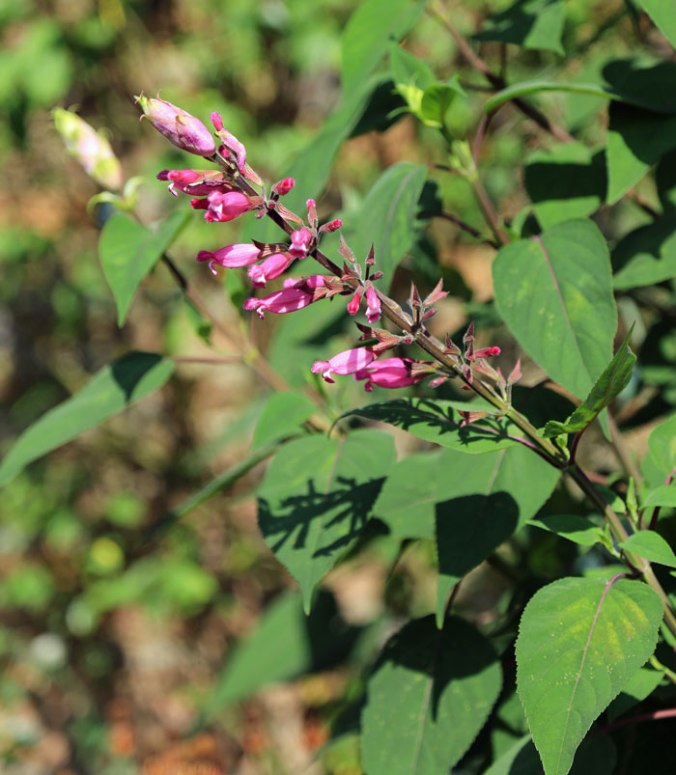October in the centre of England has been a strange month. The temperature has continued to be above average and the plants have continued to flower. It is definitely autumn with the leaves turning and dropping, all the more so with several windy periods as a couple of Atlantic storms have arrived. We are towards the east of the country so even these storms have normally moderated by the time they get to us.
 My regular view across the garden. There are still many flowers out although not as many as last month. We have not had any frost so far so the dahlias are continuing to flower. One of the negative aspect of the warm and damp weather through September and October has been the growth of moss in the lawns.
My regular view across the garden. There are still many flowers out although not as many as last month. We have not had any frost so far so the dahlias are continuing to flower. One of the negative aspect of the warm and damp weather through September and October has been the growth of moss in the lawns.  This time of year is a good time for scarification to remove any thatch and moss in the lawn. It always amazes me how much can come up with such a small machine and this is after the lawns have been cut with the normal mower.
This time of year is a good time for scarification to remove any thatch and moss in the lawn. It always amazes me how much can come up with such a small machine and this is after the lawns have been cut with the normal mower. Its a labour intensive job. After the scarification the thatch needs to be raked into piles.
Its a labour intensive job. After the scarification the thatch needs to be raked into piles. Bagged up ready to be moved around to the composting area. Then the lawn need mowing again to pick any lose material not raked up. Thank goodness it is only once a year.
Bagged up ready to be moved around to the composting area. Then the lawn need mowing again to pick any lose material not raked up. Thank goodness it is only once a year. Elsewhere a sure sign that winter is on the way is when we start to wrap the benches in the garden.
Elsewhere a sure sign that winter is on the way is when we start to wrap the benches in the garden. However, the roses continue to flower. This is mostly Rosa ‘Lichfield Angel’
However, the roses continue to flower. This is mostly Rosa ‘Lichfield Angel’ and Rosa ‘Souvenir de la Malmaison’ which also needs its winter prune to get it back into shape.
and Rosa ‘Souvenir de la Malmaison’ which also needs its winter prune to get it back into shape. Pruning climbing roses is a significant job at this time of year. This will more or less need to be taken off the wall and rearranged but………..
Pruning climbing roses is a significant job at this time of year. This will more or less need to be taken off the wall and rearranged but……….. ……….see how it will look in May. Rosa ‘Shot Silk’ is the rose.
……….see how it will look in May. Rosa ‘Shot Silk’ is the rose.
One of the stars this autumn has been Salvia ‘Phyllis Fancy’ which continues to look fantastic. View across the lawn with Salvia ‘Phyllis Fancy’ either side of the pond.
View across the lawn with Salvia ‘Phyllis Fancy’ either side of the pond.
It is getting into bulb planting time. We do not lift our tulips as most come back each year but over time they do need replenishing. My order for 2017 arrived and contains the following:
| Quantity | Name |
| 250 | Crocus Joan of Arc |
| 100 | Crocus speciosus Albus |
| 50 | Cyclamineus Narcissi Jenny |
| 100 | Narcissi Tete-a-Tete |
| 20 | Lilium Bright Diamond |
| 20 | Lilium Foxtrot |
| 10 | Lilium Purple Lady |
| 10 | Lilium Curly Sue |
| 10 | Lilium Venezuela |
| 20 | Schubertii |
| 100 | Anemone Altrocoerulea |
| 15 | Cyclamen Coum Album |
| 10 | Cyclamen Hederifolium Album |
| 25 | Eremurus Bungei |
| 100 | Iris Histrioides Katherine Hodgkin |
| 25 | Leucojum Aestivum |
| 25 | Leucojum Vernum |
| 10 | Lilium candidum |
| 100 | Tulip Exotic Emperor |
| 100 | Tulip Purissima White Emperor |
| 100 | Tulip Red Impression |
| 100 | Tulip Big Smiles |
| 100 | Tulip Elegant Lady |
| 100 | Tulip Purple Blend |
| 100 | Tulip Species Turkestanica |
We have made a start but the tulips are best not planted before November to avoid “Tulip Fire” so we are going to be busy in November with 700 bulbs to plant! Tulip fire is caused by the fungus Botrytis tulipae. It is closely related to the grey mould pathogen Botrytis cinerea. Leaf symptoms are visible from when leaves emerge in late winter until they die back in summer.
 In some areas we have started to cut back the herbaceous plants in preparation for tulips and mulching. However, with so much still flowering it seems a shame to cut out too much.
In some areas we have started to cut back the herbaceous plants in preparation for tulips and mulching. However, with so much still flowering it seems a shame to cut out too much.
The dahlias will continue to flower until the first hard frost. Here is Dahlia “Twyning’s After Eight” plus a Red Admiral butterfly! This is Geranium ‘Ann Folkard’ which will be cut back soon but is looking great right now.
This is Geranium ‘Ann Folkard’ which will be cut back soon but is looking great right now. This combination of Osteospermum ‘Tresco Purple’ and Salvia ‘Cerro Potosi’ has been looking great since June this year.
This combination of Osteospermum ‘Tresco Purple’ and Salvia ‘Cerro Potosi’ has been looking great since June this year. What is this flowering so much at the end of November? Helianthemum ‘Ben Fhada’ a flower I normally associate with the summer but I am not complaining.
What is this flowering so much at the end of November? Helianthemum ‘Ben Fhada’ a flower I normally associate with the summer but I am not complaining.
If you would like to join in with the End of Month View please do. It would be great if you could add a link to your post in the comments below and link to this post in your post.
| 2017 Gardening Hours | ||
| Week beginning October 21st |
Total 2017 to-date | Average per week |
| 28 | 883 | 21 |
Breaking News:
 Having almost completed this blog and commented on the frost free weather; this morning we had the first frost of the winter! Not enough to hurt the dahlias but they will be hit soon.
Having almost completed this blog and commented on the frost free weather; this morning we had the first frost of the winter! Not enough to hurt the dahlias but they will be hit soon.




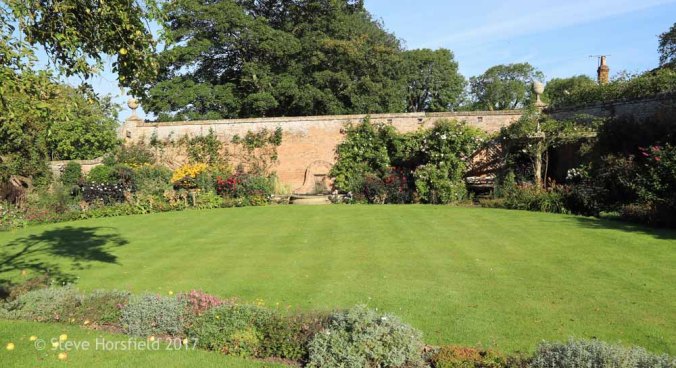 This is the view I often centre on in my EoMV, looking across our main lawn to the old kitchen garden wall.
This is the view I often centre on in my EoMV, looking across our main lawn to the old kitchen garden wall.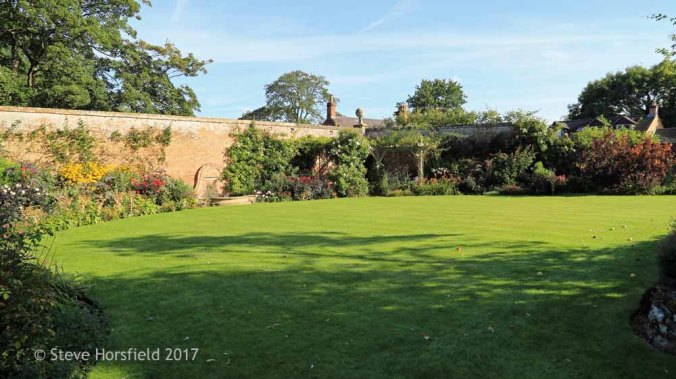 The same walls and border looking diagonally across the lawn.
The same walls and border looking diagonally across the lawn. 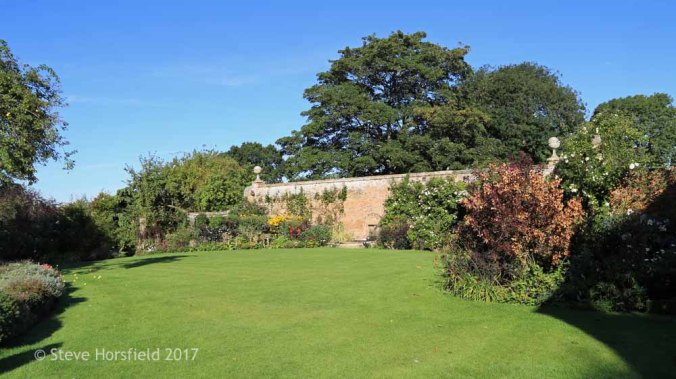 And looking along the other diagonal. Originally the kitchen garden wall extended across the lawn to form a kitchen garden enclosed on three sides and open on the fourth where there was probably a hedge.
And looking along the other diagonal. Originally the kitchen garden wall extended across the lawn to form a kitchen garden enclosed on three sides and open on the fourth where there was probably a hedge.  The late summer border is starting to look very full with many of the herbaceous plants growing very tall and needing plenty of staking to prevent them falling across other smaller plants.
The late summer border is starting to look very full with many of the herbaceous plants growing very tall and needing plenty of staking to prevent them falling across other smaller plants.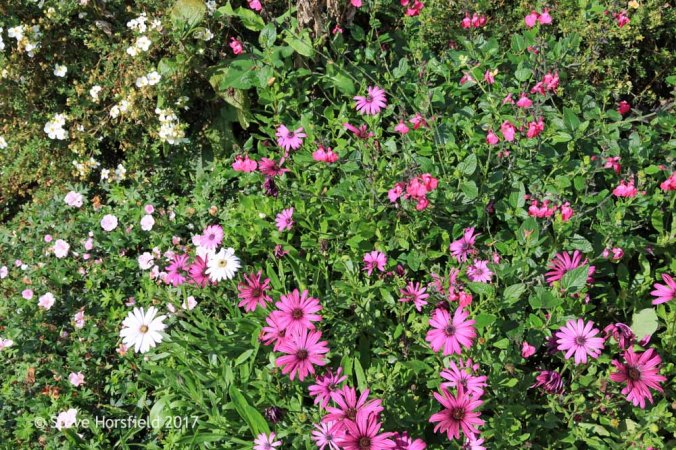 At the corner of this bed is one of those lucky combinations of colour with the soft pink of Geranium sanguineum striatum, the dark red of Osteospermum ‘Tresco Purple’ and the red of Salvia ‘Cerro Potosi’. The white/pink osteospermum is a very hardy osteospermum my mother gave me but as we do not know the variety and so we call it Nancy’s osteospermum after my mother!
At the corner of this bed is one of those lucky combinations of colour with the soft pink of Geranium sanguineum striatum, the dark red of Osteospermum ‘Tresco Purple’ and the red of Salvia ‘Cerro Potosi’. The white/pink osteospermum is a very hardy osteospermum my mother gave me but as we do not know the variety and so we call it Nancy’s osteospermum after my mother! The tall plant is Helianthus ‘Lemon Queen’. This was only planted in April this year and has certainly grown well. However, “the jury is still out” on whether it stays. Yes the flowers are there but many are covered with the green leaves. Maybe the flowers will be more prominent later in September. We will have to wait to see.
The tall plant is Helianthus ‘Lemon Queen’. This was only planted in April this year and has certainly grown well. However, “the jury is still out” on whether it stays. Yes the flowers are there but many are covered with the green leaves. Maybe the flowers will be more prominent later in September. We will have to wait to see.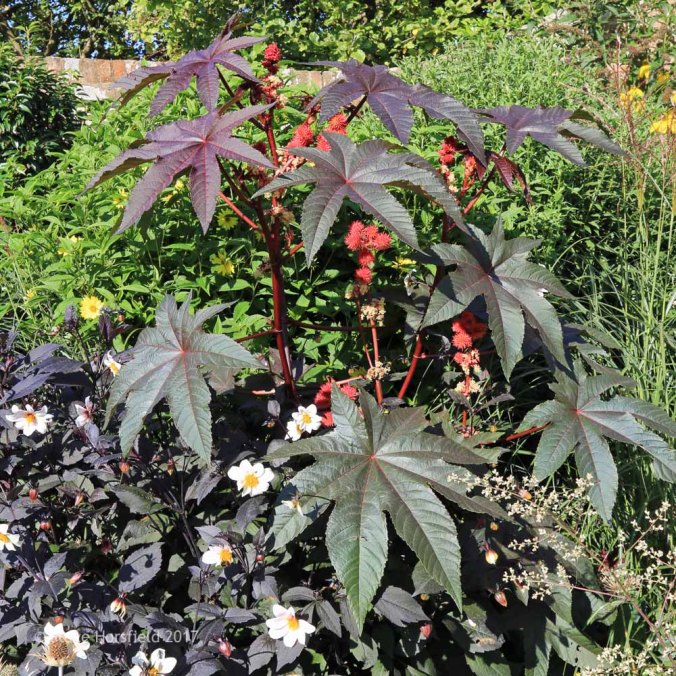 The star of the border continues to be Ricinus communis ‘Impala’
The star of the border continues to be Ricinus communis ‘Impala’  The leaves of which are absolutely fantastic. These are grown from seed and as such are only a few pence each.
The leaves of which are absolutely fantastic. These are grown from seed and as such are only a few pence each.

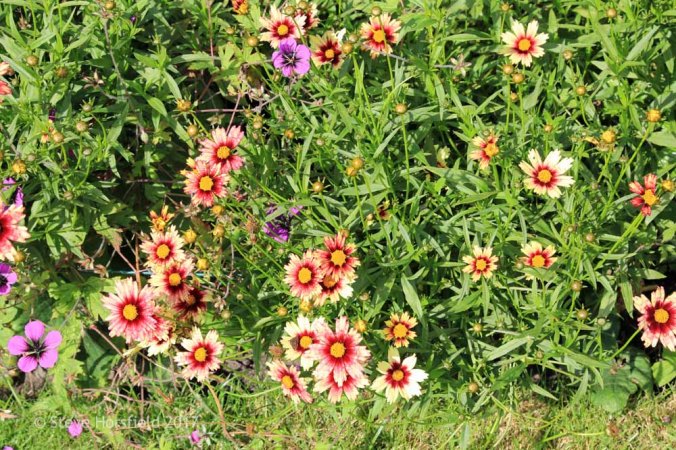 Coreopsis ‘Redshift’ a new plant this year at the front of the corner bed. Lots of flowers but seems to flop very easily.
Coreopsis ‘Redshift’ a new plant this year at the front of the corner bed. Lots of flowers but seems to flop very easily. I found this caterpillar making great speed across the lawn. It was about 3 inches long with two pairs of false eyes and a small horn on its tail. At first I was fooled and thought it was a snake! A bit of research identified it as probably an elephant hawk moth caterpillar.
I found this caterpillar making great speed across the lawn. It was about 3 inches long with two pairs of false eyes and a small horn on its tail. At first I was fooled and thought it was a snake! A bit of research identified it as probably an elephant hawk moth caterpillar. The other corner of the wall has a green oak pergola to provide a seating area and some shade. The rose growing up the pergola is Rosa ‘Blush Noisette’
The other corner of the wall has a green oak pergola to provide a seating area and some shade. The rose growing up the pergola is Rosa ‘Blush Noisette’
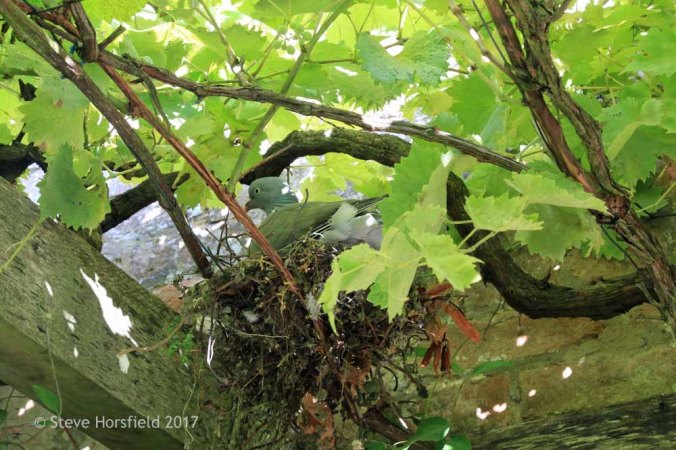 This year I could only prune half the vines back as a pigeon had decided to make a nest in the vine.
This year I could only prune half the vines back as a pigeon had decided to make a nest in the vine. 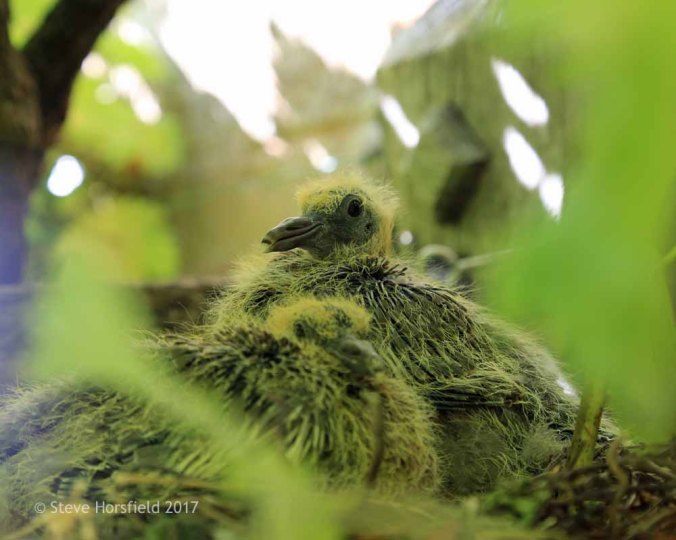 This week two chicks hatched out and are doing well but the vine remains un-pruned.
This week two chicks hatched out and are doing well but the vine remains un-pruned.

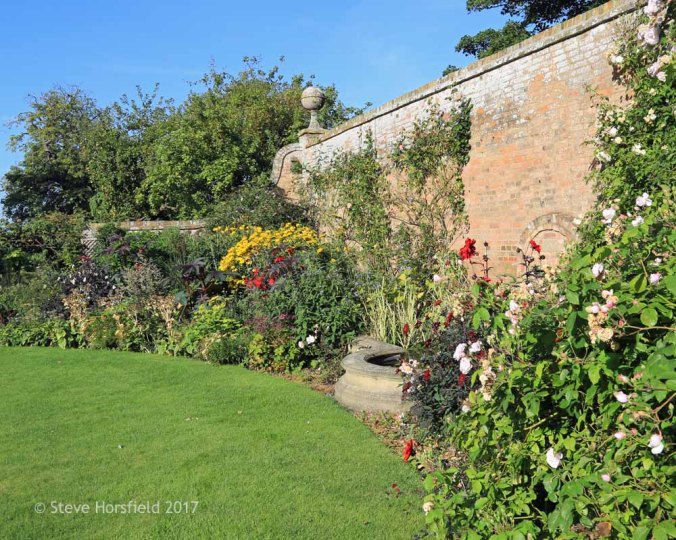 Looking back from the pergola to the corner bed.
Looking back from the pergola to the corner bed.


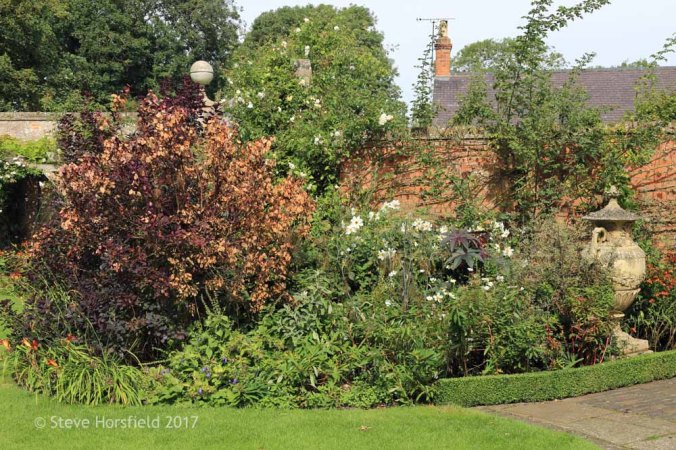 The end of the wall on the right has a very sad looking Cotinus ‘Nottcutts Variety’. Normally it has very attractive dark coloured foliage but this year it seems to be dying! The foliage has gone dry and brown and is spreading through the shrub. Looks like this will be coming out soon.
The end of the wall on the right has a very sad looking Cotinus ‘Nottcutts Variety’. Normally it has very attractive dark coloured foliage but this year it seems to be dying! The foliage has gone dry and brown and is spreading through the shrub. Looks like this will be coming out soon. Rudbeckia ‘Herbstone’ grows to almost two metres at the back of the border but does need staking to stop it falling on other plants.
Rudbeckia ‘Herbstone’ grows to almost two metres at the back of the border but does need staking to stop it falling on other plants.










 This circular bed (stone edged bed on the
This circular bed (stone edged bed on the  Rudbeckia fulgida sullivantii ‘Goldsturm’ should always have a place in the August border.
Rudbeckia fulgida sullivantii ‘Goldsturm’ should always have a place in the August border. At first this looked like a new plant formed when a Perovskia ‘Blue Spire’ decided to climb up a Foeniculum vulgare ‘purpureum’.
At first this looked like a new plant formed when a Perovskia ‘Blue Spire’ decided to climb up a Foeniculum vulgare ‘purpureum’.  I always grow some Ricinus communis ‘Impala’ from seed each year starting them off in the greenhouse and planting out when the dahlias go in. The leaves are fantastic architectural additions to any border but note that they donot overwinter here.
I always grow some Ricinus communis ‘Impala’ from seed each year starting them off in the greenhouse and planting out when the dahlias go in. The leaves are fantastic architectural additions to any border but note that they donot overwinter here.  There are many different Dahlias in our garden This is one of my favorites, Dahlia ‘Bishop of Aukland’.
There are many different Dahlias in our garden This is one of my favorites, Dahlia ‘Bishop of Aukland’. This is Phlox paniculata Uspekh a plant I saw on a garden visit and just had to have for its strong colours.
This is Phlox paniculata Uspekh a plant I saw on a garden visit and just had to have for its strong colours. Colour combinations are important in the garden. Often it is the plants themselves which seem to combine in good ways. Here we have Achillea ‘Credo’ with Salvia greggii ‘Emperor’, as close to complementary colours as you can get.
Colour combinations are important in the garden. Often it is the plants themselves which seem to combine in good ways. Here we have Achillea ‘Credo’ with Salvia greggii ‘Emperor’, as close to complementary colours as you can get. Here Helenium ‘Moerheim Beauty’ is absolutely stunning but look closely a Cerastostigma willmottianum ‘Forest Blue’ has got into the picture. Complementary colours again!
Here Helenium ‘Moerheim Beauty’ is absolutely stunning but look closely a Cerastostigma willmottianum ‘Forest Blue’ has got into the picture. Complementary colours again!

 And other day lilies have also done well, here is Hemerocallis ‘Stafford’.
And other day lilies have also done well, here is Hemerocallis ‘Stafford’. A shrubby clematis, Clematis ‘Wyevale’, comes back every year and has a long flowering period.
A shrubby clematis, Clematis ‘Wyevale’, comes back every year and has a long flowering period. Cone flowers, Echinacea purpurea, are loved by insects and look fantastic in the garden.
Cone flowers, Echinacea purpurea, are loved by insects and look fantastic in the garden.

 Osteospermums have a long flowing period and look great. This is Osteospermum ‘Tresco Purple’ which is hardy in some places but so far not here so I take cuttings every year.
Osteospermums have a long flowing period and look great. This is Osteospermum ‘Tresco Purple’ which is hardy in some places but so far not here so I take cuttings every year. Sowed a bit late but this Rudbeckia came from a packet of seed described as Rustic Dwarfs Mixed and has produced some stars. I will try getting Rudbeckia plants from seed every year now.
Sowed a bit late but this Rudbeckia came from a packet of seed described as Rustic Dwarfs Mixed and has produced some stars. I will try getting Rudbeckia plants from seed every year now. Another plant from seed is Cosmos, this is Cosmos versailles tera and produces some very strongly coloured flowers.
Another plant from seed is Cosmos, this is Cosmos versailles tera and produces some very strongly coloured flowers. This is new to me, Maurandya ‘Magic Dragon’.
This is new to me, Maurandya ‘Magic Dragon’.  Another climber, Clematis ‘Jackmanii’, has been doing great things although this year has not produced the best from clematis which I suspect was due to lack of rain through the spring.
Another climber, Clematis ‘Jackmanii’, has been doing great things although this year has not produced the best from clematis which I suspect was due to lack of rain through the spring. Last but not least, Anemone ‘Honorine Joubert’, a great plant not least because it copes with shade well.
Last but not least, Anemone ‘Honorine Joubert’, a great plant not least because it copes with shade well.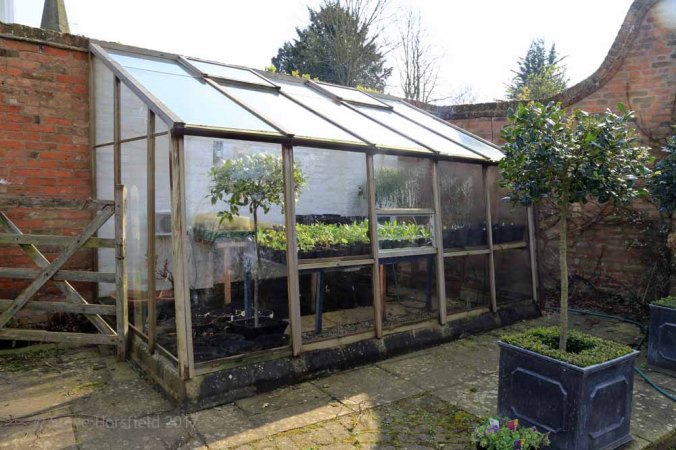 Despite having a relatively large garden the greenhouse is not very large. The location is not ideal either as it faces west and has a large wall to the south and east. You may well ask “why did you put it here?” I would say that the main reason was that we did not want to spoil the views down the garden and the only other sensible location was totally shaded by a large old apple tree. Actually the location does have the advantage that it does not get over hot in the middle of summer.
Despite having a relatively large garden the greenhouse is not very large. The location is not ideal either as it faces west and has a large wall to the south and east. You may well ask “why did you put it here?” I would say that the main reason was that we did not want to spoil the views down the garden and the only other sensible location was totally shaded by a large old apple tree. Actually the location does have the advantage that it does not get over hot in the middle of summer. At the end are Osteospermum cutting that have been over wintered and a bay tree which I bring in to protect it from the winter frosts.
At the end are Osteospermum cutting that have been over wintered and a bay tree which I bring in to protect it from the winter frosts.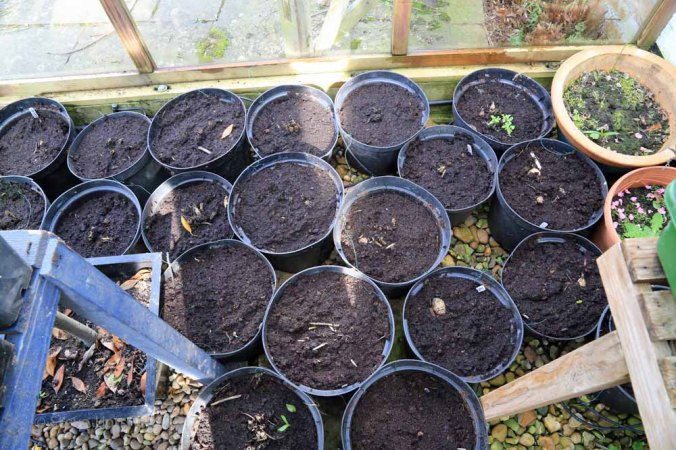 There is not enough staging so some are started off on the ground.
There is not enough staging so some are started off on the ground. On the right as you enter there are even more! The issue I have is that I always end up with more dahlia plants than I started with and I am always reluctant to throw away anything that could make a good plant. The greenhouse just get fuller!
On the right as you enter there are even more! The issue I have is that I always end up with more dahlia plants than I started with and I am always reluctant to throw away anything that could make a good plant. The greenhouse just get fuller!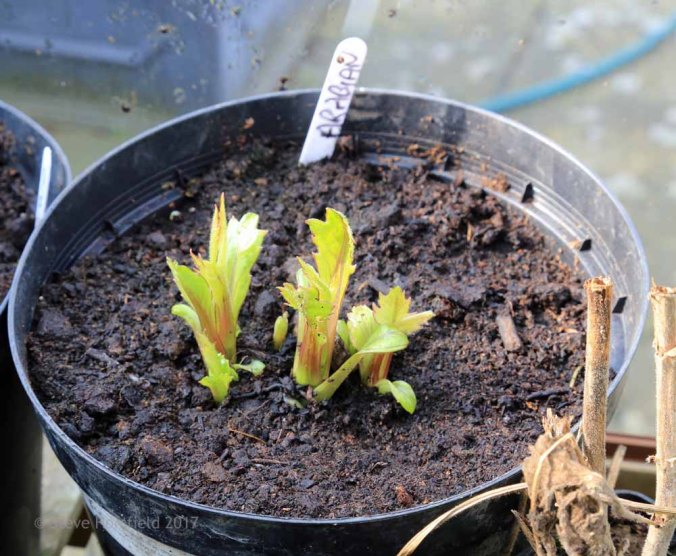 It is amazing how quickly the tubers burst into life. This one is Dahlia Arabian Night a beautiful dahlia with large, fully-double flower-heads of dark burgundy-red.
It is amazing how quickly the tubers burst into life. This one is Dahlia Arabian Night a beautiful dahlia with large, fully-double flower-heads of dark burgundy-red.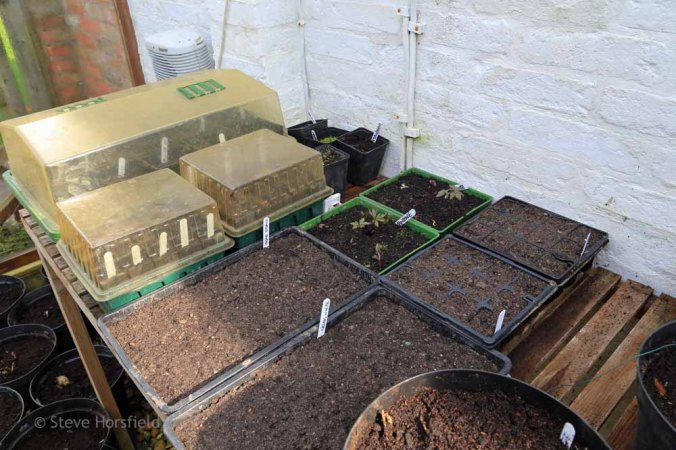 This is already underway with trays of cosmos and poppies and in the incubator tomatoes and many more exotic flowers. This becomes a huge juggling act and eventually the whole floor will be covered with plants and the scent becomes overpowering. The aconites and Anemone Blanda White Splendour have already been moved out and I described these in
This is already underway with trays of cosmos and poppies and in the incubator tomatoes and many more exotic flowers. This becomes a huge juggling act and eventually the whole floor will be covered with plants and the scent becomes overpowering. The aconites and Anemone Blanda White Splendour have already been moved out and I described these in 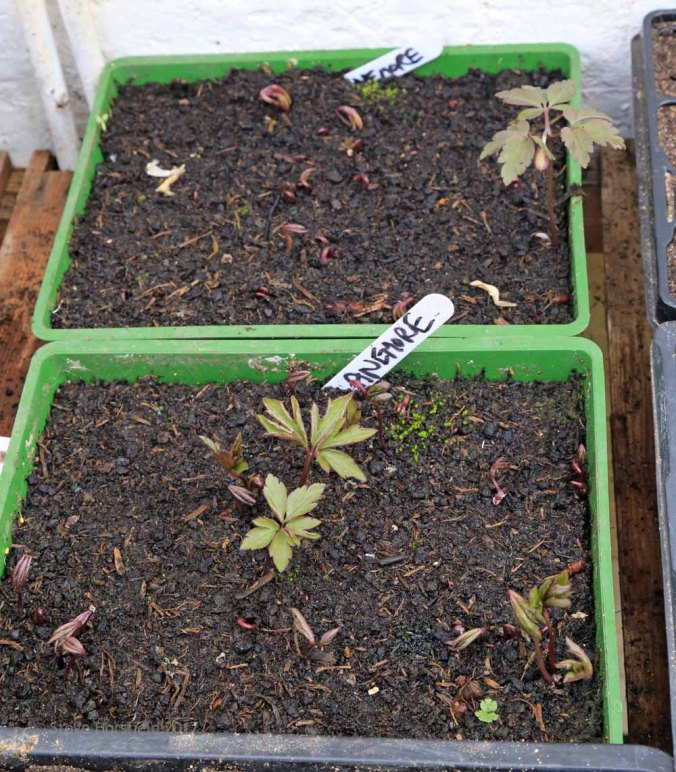 Two trays that will soon be ready to plant out are Anemone Nemerosa Robinsoniana which I treat in a similar way to the aconites.
Two trays that will soon be ready to plant out are Anemone Nemerosa Robinsoniana which I treat in a similar way to the aconites. This is the same view across the garden that I took in August. Actually I am surprised to see that there are now more flowers on show. Looking at some of these stars we have:
This is the same view across the garden that I took in August. Actually I am surprised to see that there are now more flowers on show. Looking at some of these stars we have: Osteospermum ‘Tresco Purple’ which is new in the garden this year although I have often seen it in Tresco. It has done really well and forms a low bushy plant which is claimed to be hardy. However as with all our osteospermums we take cutting which will remain in the greenhouse till next spring.
Osteospermum ‘Tresco Purple’ which is new in the garden this year although I have often seen it in Tresco. It has done really well and forms a low bushy plant which is claimed to be hardy. However as with all our osteospermums we take cutting which will remain in the greenhouse till next spring.




 Rudbeckia ‘Herbstone’ makes a huge plant at the back of the border. The main issue is supporting it from falling onto the other plants.
Rudbeckia ‘Herbstone’ makes a huge plant at the back of the border. The main issue is supporting it from falling onto the other plants. Roses are continuing to flower with the very warm weather we have been having. This is Rosa Awakening a climber on the wall.
Roses are continuing to flower with the very warm weather we have been having. This is Rosa Awakening a climber on the wall. Cosmos bipinnatus ‘Purity’ has grown and grown with some plants over six feet high which usually mean they have collapsed onto other plants.
Cosmos bipinnatus ‘Purity’ has grown and grown with some plants over six feet high which usually mean they have collapsed onto other plants. Apples, apples and more apples. This is a very old tree of unknown stock but they do keep quite well for upto six months. We will pick some for storage soon.
Apples, apples and more apples. This is a very old tree of unknown stock but they do keep quite well for upto six months. We will pick some for storage soon. Salvia ‘Cerro Potosi’ a useful hardy salvia. We cut it back each spring and it grows and grows!
Salvia ‘Cerro Potosi’ a useful hardy salvia. We cut it back each spring and it grows and grows! and at the back is this aster. It is one of the few plants that was in the garden when we moved here in 1994. It is very tall (about six feet) and very reliable but I do not know exactly what variety it is. Could be Aster praealtus any other suggestions?
and at the back is this aster. It is one of the few plants that was in the garden when we moved here in 1994. It is very tall (about six feet) and very reliable but I do not know exactly what variety it is. Could be Aster praealtus any other suggestions?




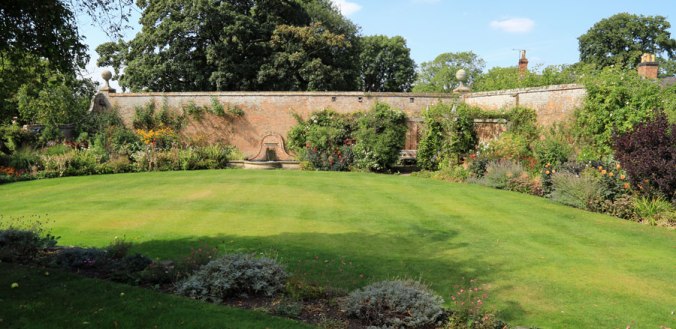 This is a view across the garden into what was originally a walled kitchen garden to the village rectory. The wall at the back is double skinned and could be heated via a fireplace and a system of brick ducts to transport the heat through the wall. The flower beds were originally only a couple of feet deep when we moved here in 1994 but has since been increased up to 12 feet deep. The pergola on the right is made from green oak and replaced one that was made from scaffolding planks and poles. The lawn, viewed from above forms a large half circle.
This is a view across the garden into what was originally a walled kitchen garden to the village rectory. The wall at the back is double skinned and could be heated via a fireplace and a system of brick ducts to transport the heat through the wall. The flower beds were originally only a couple of feet deep when we moved here in 1994 but has since been increased up to 12 feet deep. The pergola on the right is made from green oak and replaced one that was made from scaffolding planks and poles. The lawn, viewed from above forms a large half circle.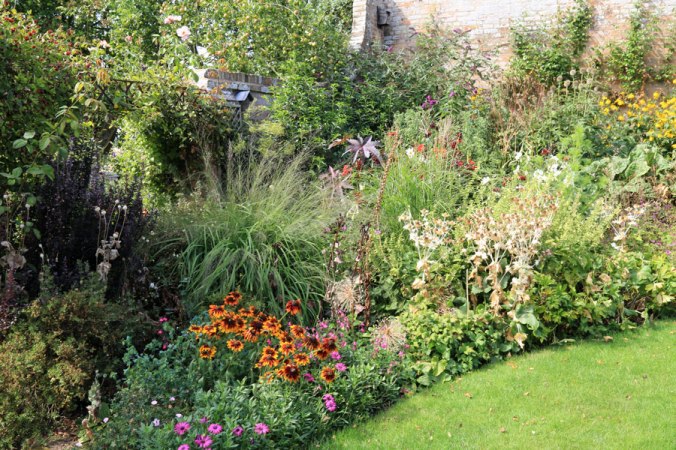 The star here is the Rudbeckia ‘Berlin’ with the Osteospermum ‘Tresco Purple’ and the Molinia caerulea grass behind. At this time of year much of this border is looking either green or brown. In the future we intend to get more gems of colour such as the Rudbeckia into the planting schemes
The star here is the Rudbeckia ‘Berlin’ with the Osteospermum ‘Tresco Purple’ and the Molinia caerulea grass behind. At this time of year much of this border is looking either green or brown. In the future we intend to get more gems of colour such as the Rudbeckia into the planting schemes With the Molinia on the left there is a bank of dahlias, ‘Bishop of Llandaff’, ‘Fairfield Frost’ & ‘Nuit D’Ete’ together with
With the Molinia on the left there is a bank of dahlias, ‘Bishop of Llandaff’, ‘Fairfield Frost’ & ‘Nuit D’Ete’ together with  The Rudbeckia ‘Herbstone’ at the back provides good colour with
The Rudbeckia ‘Herbstone’ at the back provides good colour with 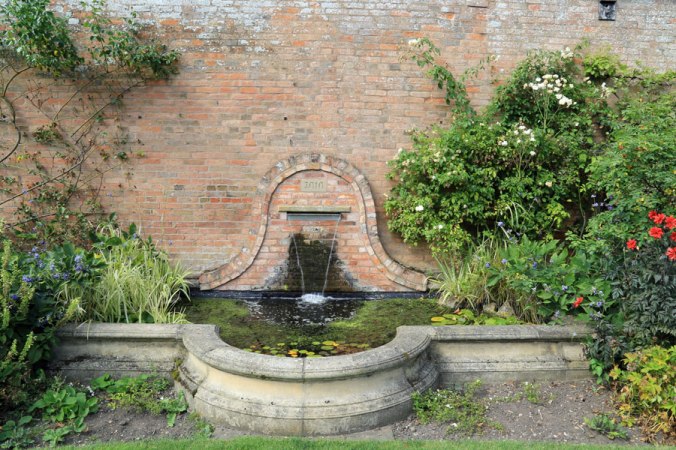 As you can see I designed and built the pond in 2010. We have been delighted with the pond but have struggled with the planting in front. Currently we have ground cover Rosa ‘Snow Carpet’ underplanted with Clematis ‘Chelsea’ neither has done that well which could be because it is a very dry spot.
As you can see I designed and built the pond in 2010. We have been delighted with the pond but have struggled with the planting in front. Currently we have ground cover Rosa ‘Snow Carpet’ underplanted with Clematis ‘Chelsea’ neither has done that well which could be because it is a very dry spot.  This border on the right has done well this year. The large Nepeta is ‘Six Hills Giant’ with dahlias ‘David Howard’ and ‘Twyning’s After Eight’. In the centre is an interesting Salvia involocruta bethellii. This salvia is cut back in the winter but so far has survived our winters and grows to around 6 feet. We normally mulch the base in winter with dry material to protect it from the frost.
This border on the right has done well this year. The large Nepeta is ‘Six Hills Giant’ with dahlias ‘David Howard’ and ‘Twyning’s After Eight’. In the centre is an interesting Salvia involocruta bethellii. This salvia is cut back in the winter but so far has survived our winters and grows to around 6 feet. We normally mulch the base in winter with dry material to protect it from the frost.